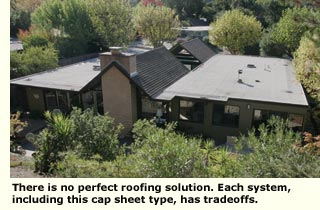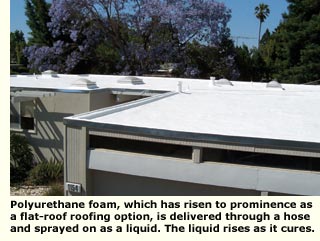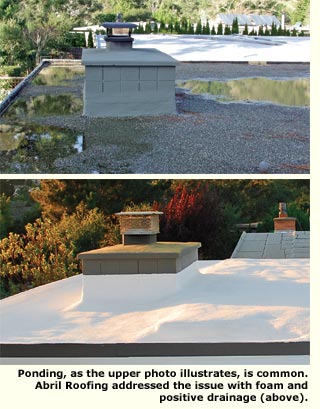Roofing Survival Guide

Leaks, weather damage, renovations, old age. No matter what the motivation, there never seems to be a convenient time to install a new roof on your mid-century modern home. And when you finally decide it's time, how will you know which system to choose?
Experienced roofers universally agree that homes with flat or low-sloped roofs are more challenging and far less forgiving than homes with pitched roofs. Consequently, roofs on Eichlers, Strengs, Cliff Mays, and Palm Springs classics by nature lend themselves to a host of unique maintenance issues.
While water will naturally drain off of a pitched roof because of gravity, with flat and low-sloped roofs there are ponding issues, there are draining issues, and both of these woes can lead to leaks and other water damage over time. It's no wonder that many roofers surveyed in the Bay Area say on average that owners of these homes wind up re-roofing every 12 to 15 years.
Re-roofing is not an easy project for a homeowner. Numerous options abound—and specialists for each type will tell you their system is better than the next. While the tar-and-gravel system is still a viable option for flat and low-pitched roofs, roofing choices have come a long way since the 1950s, when virtually all of our modern homes were originally christened with T&G.

Today, in addition to tar and gravel, a host of newer technologies exist: multi-ply modified bitumen, polyurethane foam, an array of single-ply systems, and of course up-and-coming challengers banging at the door who have yet to be fully tested for longevity.
But there is no perfect roofing solution. Each type of roof offers tradeoffs with respect to cost, insulating properties, longevity, and other elements—so the 'best' choice for you may not be the same as for your neighbor next door.
How can an average homeowner practically sort out all of these options—and without suffering a meltdown?
"There's really no book in the library that can teach you about all the different methods of roofing," says Eduardo Peña of Responsible Roofing, a tar-and-gravel company based in Redwood City. "You just have to call up companies and get detailed information about the materials they use."

Finding the right company is also important. "You need to make sure you choose someone who's been around for a long time," says Randy Feriante, owner of Dura-Foam, Inc., a foam applicator located in Menlo Park. "[For best results,] you're not going to go with the cheapest guy. You're going to make sure the guy can do the job."
"Don't listen to one person—look at different options," adds John Rossi of Cal-Pac Roofing, in San Mateo, who specializes in installations of the Duro-Last single-ply system. "The Eichler Network and the Better Business Bureau—that's where you're going to find the most reputable people."
The first step in selecting the ideal roofing system and installer for your home is to examine your needs. Begin by asking yourself some key questions:
- How old is my roof?
- Is it in good condition, or are there signs of excessive wear, such as blistering, ponding, or cracking?
- Is repairing an option, or does it make sense to replace?
- How long do I expect to remain in the house?
- Are aesthetics important to me? If so, what look do I prefer?
- Do I want to take a purist's approach (wanting my home to be close to original), or are contemporary options attractive?
- Do I need additional insulation, or is my present roofing system or the insulation underneath it sufficient?
- What is my budget?
If repairing is not an option, then it may be time to replace your old roof; but now you will be faced with other issues to ponder. For example, what type of roof do I want? Should I add insulation? What about adding skylights or upgrading the electrical? Are there other options to consider while my roof is opened up?
Many factors should be considered during the process of choosing the ideal type of roofing for your home. These include cost, waterproofing capabilities of the material and installation method, reflectivity of the top coating (does it reflect light, or hold it in?), weight of the material, presence or absence of seams, and application method.





